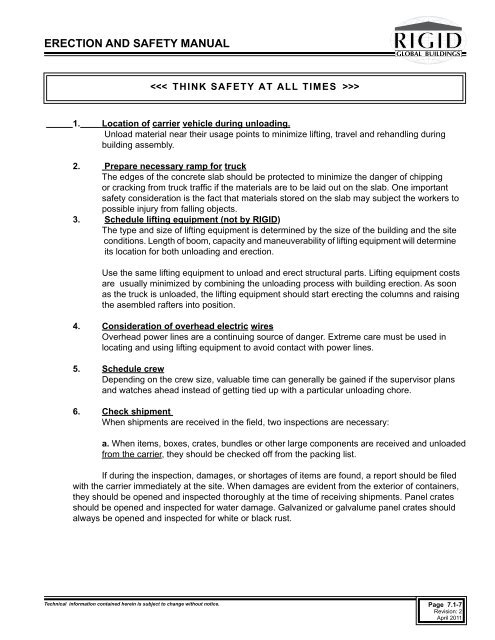ERECTION AND SAFETY MANUAL - Rigid Global Buildings
ERECTION AND SAFETY MANUAL - Rigid Global Buildings
ERECTION AND SAFETY MANUAL - Rigid Global Buildings
Create successful ePaper yourself
Turn your PDF publications into a flip-book with our unique Google optimized e-Paper software.
<strong>ERECTION</strong> <strong>AND</strong> <strong>SAFETY</strong> <strong>MANUAL</strong><br />
><br />
1. Location of carrier vehicle during unloading.<br />
Unload material near their usage points to minimize lifting, travel and rehandling during<br />
building assembly.<br />
2. Prepare necessary ramp for truck<br />
The edges of the concrete slab should be protected to minimize the danger of chipping<br />
or cracking from truck traffi c if the materials are to be laid out on the slab. One important<br />
safety consideration is the fact that materials stored on the slab may subject the workers to<br />
possible injury from falling objects.<br />
3. Schedule lifting equipment (not by RIGID)<br />
The type and size of lifting equipment is determined by the size of the building and the site<br />
conditions. Length of boom, capacity and maneuverability of lifting equipment will determine<br />
its location for both unloading and erection.<br />
Use the same lifting equipment to unload and erect structural parts. Lifting equipment costs<br />
are usually minimized by combining the unloading process with building erection. As soon<br />
as the truck is unloaded, the lifting equipment should start erecting the columns and raising<br />
the asembled rafters into position.<br />
4. Consideration of overhead electric wires<br />
Overhead power lines are a continuing source of danger. Extreme care must be used in<br />
locating and using lifting equipment to avoid contact with power lines.<br />
5. Schedule crew<br />
Depending on the crew size, valuable time can generally be gained if the supervisor plans<br />
and watches ahead instead of getting tied up with a particular unloading chore.<br />
6. Check shipment<br />
When shipments are received in the fi eld, two inspections are necessary:<br />
a. When items, boxes, crates, bundles or other large components are received and unloaded<br />
from the carrier, they should be checked off from the packing list.<br />
If during the inspection, damages, or shortages of items are found, a report should be fi led<br />
with the carrier immediately at the site. When damages are evident from the exterior of containers,<br />
they should be opened and inspected thoroughly at the time of receiving shipments. Panel crates<br />
should be opened and inspected for water damage. Galvanized or galvalume panel crates should<br />
always be opened and inspected for white or black rust.<br />
Technical information contained herein is subject to change without notice. Page 7.1-7<br />
Revision: 2<br />
April 2011


